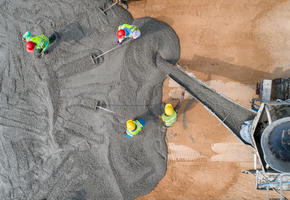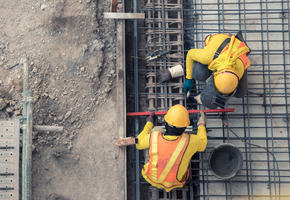Unlike steel, there isn’t yet a globally agreed standard for what is considered low embodied carbon and indeed a definition of net zero concrete. This is key to aligning the industry and building the collective action that’s needed to get the concrete industry to net zero. But right now, there’s not enough data on the level of carbon emissions associated with the concrete that’s already being used. And without this we don't have a good understanding of the embodied carbon of concrete in a business as usual scenario. We need this to understand our impact and compare this to benchmarks. Climate Group’s ConcreteZero campaign brings businesses together to not only create a market for sustainable concrete, but to drive greater transparency on carbon emissions across the concrete industry.
Jen Carson, Head of Industry at Climate Group, spoke to Ben Azoula-Victory, Concrete Technologist at Byrne Bros, on how Byrne Bros is working to decarbonise the concrete industry through measuring and reporting:
JC: We were delighted to launch ConcreteZero in July of this year with Byrne Bros as a founding member. It’s really encouraging to see so many businesses leading the charge on decarbonising one of the most highly used materials on the planet. Why did Byrne Bros decide to take action on concrete now?
BA-V: As a leading specialist concrete contractor, with more than 50 years’ industry experience, we recognised the climate impact of our main construction material, concrete.
We’ve been working with low cement free and low carbon concretes since at least 2013. In 2019 our technical team committed to sharing all our data freely with industry, for the benefit of the industry and a sustainable future. We all believed that holding onto competitive advantage in this field is counter-productive to the net zero objective and we also recognised that we can’t drive change alone, that’s why we joined ConcreteZero.
We saw how extensive collaboration between the Low Carbon Concrete Group (LCCG) and ConcreteZero was boosting knowledge across our sector and how this was driving a clear demand signal for sustainably produced concrete. Working together across supply chains, sectors and geographies is absolutely central to getting to net zero.
JC: You’re right, collaboration is key but so too are measuring and reporting tools to driving decarbonisation. Appropriate tools and frameworks will build knowledge on how to cut the associated carbon emissions from concrete mixes and will align the industry on what’s needed to get to net zero. Are you already measuring and reporting on your carbon emissions linked to concrete?
BA-V: Absolutely, we’ve been reporting internally on the carbon intensity of our concrete for all of our projects for several years, but our most effective work really began in 2019. At that time the industry saw a surge in low carbon concretes, but four of us in Byrne Bros were frustrated by a lot of the claims being made of ‘innovative’ low carbon concretes, for example marketing concrete mixes that the industry has been using for years as ‘low carbon’ innovations. Together we set about developing a reliable baseline that would stand up to scrutiny.
We’ve been working with structural engineers, architects, clients and ready mix producers to analyse and gather data on concrete mixes between 2015 and 2020 to better understand the climate impact. This information is key to bringing transparency on the carbon emissions related to concrete so we’ve been sharing this widely with the industry including our competitors.
ConcreteZero is going one step further. All ConcreteZero members have committed to monitoring and reporting their CO2 emissions linked to concrete through a digital platform, which will allow data to be shared (anonymously) amongst members. The design of this platform is well underway and will importantly provide us with a standardised methodology for benchmarking performance and recording the improvements our members are making. It will allow more accurate targets to be set based on seasonal, geographical and structural use of concrete.
JC: We’ve touched a little on why data is important to driving change, but specifically, why is it key to Byrne Bros’ sustainability strategy for concrete?
BA-V: Our approach is structured around two main channels:
- What can we do with existing materials within the current standards and codes of practice without impacting on cost or programme?
- How can we support innovative concrete products to achieve a route to specification?
As members of ConcreteZero we are committing to use 30% low emission concrete by 2025 and 50% by 2030, with a long-term target of 100% by 2050. Using our 2015-2020 baseline we’ve been able to demonstrate that we’re already significantly ahead of the UK average in reducing concrete carbon intensity. We also looked at redefining the mixes from that period to achieve minimum CO2 levels, with no impact to cost or programme. We’ve developed ‘stretch’ targets which push innovation of the concrete mixes we use to the very boundaries of their performance – this is key to driving change now.
We can apply this strategy to each project – as every development presents its own unique opportunities for carbon reduction, it’s not one size fits all. This robust approach allows us to guide clients, designers and other stakeholders through the options and allow them to make fact-based decisions to forecast the carbon intensity of a project. From this they are empowered to balance their sustainability aspirations with budgetary constraints. Our depth of knowledge and collaborative approach has led to early client engagement and project wins.
JC: Collaboration with industry experts, businesses and with governments is really core to what we do at Climate Group with ConcreteZero. How important is data and information in building and informing these connections for Byrne Bros?
BA-V: Through our work with the LCCG and the development of its Low Carbon Concrete Routemap we’ve contributed to the creation of a robust tool for measuring ‘what good looks like’. The information gathered through this tool will be key to accelerating the net zero transition for concrete production.
And this is only set to strengthen through the extensive collaboration between LCCG and ConcreteZero which allows businesses to pool our knowledge and experiences of tackling the carbon emissions associated with concrete.
The reality is that many policy makers don’t understand the detail and, as we’ve found, there is a paucity of data available. The ConcreteZero work to collate and share data across industry and present it in easily understood gradings will allow policy makers to set meaningful parameters for operation. These could include carbon taxes set by governments, sustainability caps set by local planning authorities or (what we’d really like to see) developer led targets supported by project teams each with their own aspirations.
JC: Lastly, in your view, what do you believe is holding back the carbon agenda in your sector?
BA-V: Solutions to reduce the embodied CO2 of concrete exist within the UK, but they require early engagement and a collaborative approach rarely seen in construction. They also incur additional cost and given that the current cost of offsetting can be as little as £10/tCO2e1, there is little incentive for clients to opt for reduction solutions over offsetting. Even the best value lower emission concrete options are more expensive than the cheapest offsets. But that’s at the moment – and things can, and will change quickly. Aspirational clients are key to the industries’ fledgling technologies, which need uptake today to provide tomorrow’s solutions.
Novel concretes exist which have been successfully used in other areas of the globe, such as Australia. Yet they fall outside of the current standards and require ‘design assisted by testing’ to be used in a meaningful way in the UK i.e., in large permanent structures. Work is underway to accommodate novel concretes within the standards, but this arduous process will not be quick and there can be reluctance from various stakeholders to engage in something new. In the interim we strongly (or a better word) call on aspirational clients to continue to drive demand for the use and development of these technologies – in the full belief and knowledge, that we are creating the new business-as-usual for the future concrete industry.



